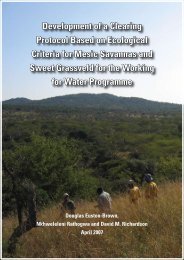Metsi Consultants - DWA Home Page
Metsi Consultants - DWA Home Page
Metsi Consultants - DWA Home Page
Create successful ePaper yourself
Turn your PDF publications into a flip-book with our unique Google optimized e-Paper software.
11.4.4 Wild Vegetables<br />
Report No 678-F-001<br />
METSI CONSULTANTS: SUMMARY OF MAIN FINDINGS FOR PHASE 1 DEVELOPMENT<br />
Wild gathered roots, tubers, rhizomes, leaves, fruits and flowers are very important nutritional sources for rural<br />
people dependent on white maize and small quantities of other grains for their staple diet. The IFR field studies<br />
indicated a total harvest of something like 2000 tonnes of fresh biomass taken annually from the riparian zones.<br />
Under the Treaty Scenario the value of the resource loss is estimated at about M 659,000 annually.<br />
The current (upstream) LHWP compensation programme does not specifically address vegetable plots at the<br />
level of the village or individual household, but does provide compensatory fruit trees to displaced villages. The<br />
LHWP development programme has focussed on the upgrading of rural horticulture through establishment of<br />
seed stores and development of small-scale irrigation. Numerous NGOs are currently working successfully in the<br />
Lesotho highlands to improve village horticulture through provision of seeds and extension services.<br />
11.4.5 Forage<br />
Riparian zones represent valuable sources of livestock forage, especially in dry periods. No estimates of the<br />
annual production of forage grasses in riparian zones are available, and a national "rule of thumb" value of 604<br />
kg/ha has been applied to riparian zones impacted by flow reductions, giving an overall forage production in the<br />
affected river reaches of about 4400 tonnes annually. This likely underestimates the true amounts of forage<br />
biomass available to livestock along the river reaches, which are more productive than the non-riverine areas due<br />
to more favourable moisture conditions. The value of the foregone forage is based on the current costs of hay in<br />
the highlands. If hay were used as the compensation basis then the costs of delivery would have to be added -<br />
these would be considerable for the remotely located areas along the downstream river reaches. Losses due to<br />
flow reduction are estimated at ~M 80,000 annually for the Treaty Scenario<br />
11.4.6 Public Health<br />
The public health component of the IFR study predicted serious consequences of Treaty minimum releases for<br />
the health of downstream communities, already in a poor state. Critically severe impacts are expected for<br />
diarrhoeal diseases and nutritional status. The risk of skin and eye diseases in some areas is expected to be<br />
severe. Community health deterioration is already evident in IFR Reach 2 immediately downstream of Katse<br />
Dam. The costs of mitigating the major health impacts through child immunisation, water and sanitation provision<br />
and health education in the case of the Treaty Scenario is estimated at slightly under M610,000 annually. Based<br />
on the costing approach adopted, small increments in water release (e.g., from Treaty to Fourth Scenario) would<br />
make little difference to these costs.<br />
Public health programmes upstream of the LHWP Phase 1A structures have to date focussed on deployment of a<br />
small number of public health teams, bolstering the levels of public information on health-related issues, and on<br />
providing clean water and effective sanitation. To date about half the villages in the Katse local catchment have<br />
been provided with piped water, and about half the households and schools now have access to VIP latrines. The<br />
programme could logically be extended to the downstream areas but two major constraints would be present - the<br />
very poor access to many downstream villages and the problem of assuring equity for downstream communities,<br />
some of which are within the zone of influence of the river and others not.<br />
65

















